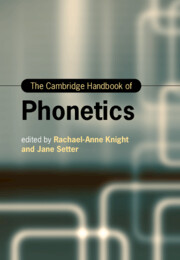Book contents
- The Cambridge Handbook of Phonetics
- Cambridge Handbooks in Language and Linguistics
- The Cambridge Handbook of Phonetics
- Copyright page
- Contents
- Figures
- Tables
- Contributors
- Introduction
- Section I Segmental Production
- Section II Prosodic Production
- Section III Measuring Speech
- 10 Measuring Vowels
- 11 Measuring Consonants
- 12 Measuring Speech Rhythm
- 13 Fundamental Frequency and Pitch
- 14 Observing and Measuring Speech Articulation
- 15 Beyond Functional Speech Synthesis
- Section IV Audition and Perception
- Section V Applications of Phonetics
- Index
- References
15 - Beyond Functional Speech Synthesis
from Section III - Measuring Speech
Published online by Cambridge University Press: 11 November 2021
- The Cambridge Handbook of Phonetics
- Cambridge Handbooks in Language and Linguistics
- The Cambridge Handbook of Phonetics
- Copyright page
- Contents
- Figures
- Tables
- Contributors
- Introduction
- Section I Segmental Production
- Section II Prosodic Production
- Section III Measuring Speech
- 10 Measuring Vowels
- 11 Measuring Consonants
- 12 Measuring Speech Rhythm
- 13 Fundamental Frequency and Pitch
- 14 Observing and Measuring Speech Articulation
- 15 Beyond Functional Speech Synthesis
- Section IV Audition and Perception
- Section V Applications of Phonetics
- Index
- References
Summary
As synthetic voices enter the mass market, there is an increasing need for voice personalisation, that is, a voice for the text-to-speech system that not only conveys information but also exudes a persona much like the human voice. We begin this chapter with a historical overview of the field starting with model-based approaches, to concatenative systems and finally to contemporary implementations of parametric synthesis. We then examine how the confluence of increased computational speed at reduced costs, the availability of large data sets, and advances in machine learning and artificial intelligence enable a whole new approach to speech synthesis, including the ability to create high-quality personalised voices. We then examine the role of crowdsourcing in developing a scalable method for voice customisation and adaptation. We discuss the benefits and challenges of acquiring recordings of novice voice talent of all ages from around the world and using these recordings for voice building. We conclude by discussing the impact of personalised voices and implications for future work.
- Type
- Chapter
- Information
- The Cambridge Handbook of Phonetics , pp. 387 - 404Publisher: Cambridge University PressPrint publication year: 2021



